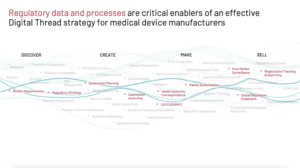From Silos to Synergy
Building a Connected Regulatory Information Management Ecosystem
Regulatory users in the medical device industries know all too well that poorly integrated systems create data silos. Managing global portfolios manually or in silo systems with an ever-changing regulatory environment can become a seemingly impossible task even for the most seasoned regulatory teams. With planning, execution, and tracking in separate, disjointed systems - compliance is challenging, making end-to-end visibility for product and regulatory data nearly impossible.
Consequently, these users can end up spending countless hours locating information spread across multiple systems and having no way of knowing if that data is up to date. Aside from the lost hours looking for information, these issues can cause compliance risks, slipping timelines, increase the probability of receiving a deficiency, and lead to revenue losses and fines due to ineffective submissions and delayed renewals.
These problems often start with issues with an organization’s Regulatory Information Management systems, or lack thereof.
What is Regulatory Information Management?
Regulatory Information Management systems (RIMS) are software solutions used by the medical device industry to manage regulatory data, ensuring compliance and minimizing regulatory risks.
This data can include:
- Where products are registered for sale
- When those registrations expire
- Universal device identifiers (UDIs) associated with those products
- Technical files and dossiers
- Standards and country-specific requirements
- Submission documentation
- The status of those submissions and more

Leading medical device companies are leveraging RIMS to consolidate, analyze and manage global regulatory information, submission planning, activity status, agency correspondence and commitments for the products that they manufacture.
RIMS coupled with advanced analytics, machine learning, extended reality and robotic process automation establishes a powerful digital regulatory thread that delivers connectivity, traceability, automation, and predictive insights. Advanced dashboards and analytics modules can provide advanced reporting and analytical capabilities to the enterprise.
However, not all RIMS are created equally.
Common Pain Points
Common RIMS pain points include poorly integrated product lifecycle management and quality management systems, entirely manual processes, insufficient change management support, and poor data visibility and reporting capabilities.
A disjointed product and regulatory change process has the potential for delayed submissions and recalls or market lock-out due to improperly assessed changes invalidating a registration or license.
But that’s not all! The trouble caused by product recalls can then be exacerbated by poor data visibility which brings uncertainty about where those products are registered to sell. This uncertainty can trigger compliance failures such as shipping to an unauthorized country or failing to notify a country of a recall.
As companies continue to expand into new markets and existing markets become more tightly regulated, RIMS has transitioned from being nice-to-have into a necessity.
Coupling RIMS capabilities with Product Lifecycle Management (PLM) and Quality Management Systems (QMS) eliminates common data silos and provides regulatory users with a single source of truth for product, quality, and regulatory data.
Your solution should:
- Track market authorizations, dependencies and renewals.
- Maintain SKU-Registration traceability.
- Reduce time spent looking for up-to-date information and manually maintaining technical files.
- Support collaboration and minimize regulatory risks associated with regulatory impact assessments for product and process changes.
- Support global regulatory teams with compiling and publishing submissions for target markets.
- Enable regulatory users to track deficiencies and correspondence with health authorities.
- Work with product data, change management and other foundational PLM Capabilities, enabling regulatory, as well as the entire enterprise, to work off a single source of information.
Integration with product and regulatory data and change processes can also improve collaboration between engineering and regulatory or compliance teams. A harmonized impact assessment helps ensure that product teams are aware of the regulatory impacts of their changes and alerts regulatory or compliance teams of those changes so that they can notify health authorities as needed. These notifications are further facilitated by the enhanced data visibility provided by RIMs which links country registrations directly to the products that they’re associated with. Assigned users will be notified automatically when those registrations are approaching expiration and need to be renewed.
These features help to maintain regulatory compliance, prevent products from being shipped to unauthorized countries, and ensure that health authority communications are tracked.
Business Value Benefits of RIMS
All these features allow for efficiency gains and harmonized processes that free up employees to focus on higher value work. The features also supports the creation of effective submissions, and improves time-to-market, which drives increased revenue and reduces the chances of receiving fines or penalties. Let’s dive a little deeper into each of those benefits:
- Expand and accelerate international sales: Reduce time and effort to register product variations per jurisdictional requirements; know where product variations are registered and salable
- Reduce regulatory risk: Prevent shipment of unauthorized or non-compliant products; understand the impact of design changes; respond quickly to changing regulations; know where to report adverse events or conduct product recalls
- Make better decisions: Improve planning and strategic decisions with better information
- Reduce manual effort of strained resources: Free people to focus on higher value work; avoid wasted hours hunting for the ‘latest-and-greatest' submission content; eliminate manual maintenance of technical files
Medical device manufacturers are continuing to expand into new markets, and existing markets, like the US and EU, are only becoming more regulated. Staying compliant in this world requires better tools than spreadsheets and word documents. Your organization needs a robust, rapidly deployable, scalable solution that can increase speed to market, mitigate regulatory and compliance risk, reduce manual effort, and enable better decision-making, helping companies succeed in a competitive business space.


